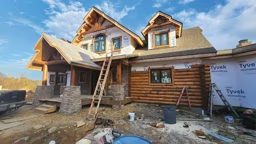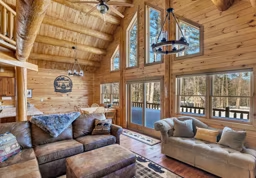
Photo: JK Lawrence
Handcrafted log homes hold a special place in the history and development of the Western world. They were among the first structures built by European settlers on the North American continent, and the technique was even adopted by indigenous tribes, like the Cherokee and Choctaw.
In the beginning, handcrafted cabins were testaments to simplicity and efficiency. Typically built with the hardiest trees in the forest (oak, walnut) and backbreaking tenacity, settlers used the most basic tools at their disposal — the ax, the drawknife, the adze — to craft anything from dwellings to churches, many of which still stand.
Today, exceptional craftsmanship and longevity remain the hallmarks of handcrafted log homes, and, in fact, the fabrication process and tools used to create them are little changed from those of our forefathers. What has drastically changed, however, is the artistry that goes into the design and construction of these monuments to all-natural living.
From the comfort of their log yards, handcrafters choose uniquely shaped logs that span the full length of a wall, then cut and notch each timber to fit one specific location in the structure. Once the cuts are made, erection is given a test run, as the handcrafter stacks the logs in the yard just as they would on site, to ensure a precise fit. The logs are then labeled, disassembled and trucked to the job site for construction.
Handcrafted logs are usually larger than their milled-log counterparts, ranging in diameter from 14 to 28 inches and spans as long as 45 feet. Douglas fir and western red cedar are two of the most frequently used species, thanks to their straight grain and dense wood fibers.
Along with wood species, you’ll have to decide what shape you want your walls to be. Two common log “profiles” are square and round, and in terms of corner systems, many handcrafters favor saddle-notch (round) or dovetail (square) corners to create a tight joint. The surface can be fairly smooth to the touch or highly textured. The bark can be removed completely or some traces can remain (a technique called “skip-peeling”) depending on the look you’re hoping to achieve.
A variety of materials are used to make a handcrafted log home weather tight, but chinking is the most popular. It not only provides a snug, flexible seal between the log courses, its contrasting white hue gives walls added character.
On erection day, it will take an experienced crew, using a crane, about three days to stack a 2,500-square-foot house; and in terms of cost, expect to pay as much as 20 percent more for a handcrafted home than its milled-log cousin. But if you’re looking to live in a one-of-a-kind work of art, a handcrafted log home is hard to beat.
See also: The Four "S"s of Picking a Log Package











